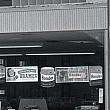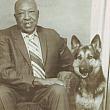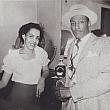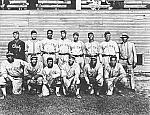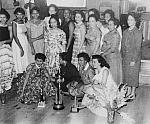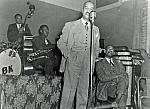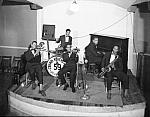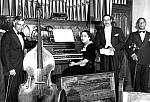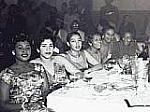
Club Indigo (Roma Hall)
by Kim Rush, John Russo, and Martin Starr
In addition to having served at one time as the Club Indigo house band leader and performing there regularly from 1936 to 193, Bennie Carew played regularly at various clubs in Detroit, Lansing and Grand Rapids with his territorial band during the 30s and 40s. A Chicago Defender article from May 22, 1937 stated that he was “now performing exclusively at Club Indigo.” Arno Marsh: ”I know that my father (Bill Marsh) played in some of the early nightclubs in Grand Rapids. My dad took me to some club out on South Division (possibly Brown Derby) when I was five or six. He was working with Benny Carew at that time. I was born in 1928 so it had to be around 1933.” Benny had an engagement at a white-owned café named Hattem’s as early as April of 1938. Benny nearly dominated the entire jazz scene around Grand Rapids for decades, at least in the sense of being steadily employed.
 Bennie Keys
Bennie Keys
Bennie Keys also performed regularly at Club Indigo, even before he moved permanently to Grand Rapids from Chicago in 1937, after his mother died. He was an established bandleader, dance performer and instructor in Chicago during the 30s. Reportedly, he worked as a dance instructor, hired by Al Capone’s brother. He danced for Duke Ellington at the Cotton Club, and served as trainer for the other dancers. Bennie Keys, Jr., “My dad really talked about New York a lot…. how he traveled with Louis Armstrong and Josephine Baker, the dancer. He dated her in the 1930s. He also mentioned knowing Sammy Davis, Jr. He met many of the big talents of that day, including ‘Bojangles’ and Lena Horne, whom he trained to dance.” During 1935 and 1936 Bennie and his band were working in Washington D.C. and New York City. He worked as a tap dancer, singer and drummer in Grand Rapids, performing regularly for many years. The late 40s and early 50s were the early days of Frank (Fred) Lamar’s legendary Horseshoe Bar at 333 Grandville Avenue, S.W. At that time, Benny served as the bandleader for this nightclub. He also taught children how to dance and staged performances that showcased their skills. During the day he worked as a plumber. He died in Grand Rapids in 1988.
Entertainment Beyond Roma Hall
Club Indigo members often extended their influence far beyond Roma Hall. During the late 30s, Milo Brown, attorney John Shackelford, and Frank Lamar sponsored concerts, floorshows and dances around Grand Rapids, some at typically white venues. Jazz musicians Jimmy Raschel and Claude Hopkins appeared at the Regent Roof Gardens in 1936. The “Chicky Bar” (Chicky Candy Bar) Negro league baseball team, .jpg) managed between 1930 and 1937 by John Shackelford and Frank Lamar, brought Louis Armstrong to the Civic Auditorium on 7.13.1936. Musician Jean Calloway also performed at the Civic Auditorium in August of this same year. Mrs. Walter Coe and the Pierian Club sponsored “noted screen and radio star… and outstanding Race artist” Etta Moten to appear at St. Cecilia on February 11, 1938.[1] There were also floorshows and dances staged at Little Eden on Knapp N.E. and the Sunshine Hall at 100 Commerce, at the corner of Oakes, S.W.
managed between 1930 and 1937 by John Shackelford and Frank Lamar, brought Louis Armstrong to the Civic Auditorium on 7.13.1936. Musician Jean Calloway also performed at the Civic Auditorium in August of this same year. Mrs. Walter Coe and the Pierian Club sponsored “noted screen and radio star… and outstanding Race artist” Etta Moten to appear at St. Cecilia on February 11, 1938.[1] There were also floorshows and dances staged at Little Eden on Knapp N.E. and the Sunshine Hall at 100 Commerce, at the corner of Oakes, S.W.
"City's Only Sepia Night Spot"
Mrs. Skinner’s Chicago Defender column, published on 8.13.38, maintained “Club Indigo was the city’s only sepia night spot.” But even though Grand Rapids’ financially successful and socially prominent African-Americans had selected Club Indigo as the designated venue for their events, they did not own the building. In June of 1940, “Minstel Frolics,” a stage show and play composed of fifty characters, starring local musician James Hugo and police lieutenant Walter Coe, was staged at Ramona Park Theater. Proceeds were to be used by Crispus Attucks American Legion Post # 59 for a youth recreational center. The post had been staging events since at least 1935, such as a dance that year at Grand River Gardens. Coe was the commander of the post at that time. Originally, he had moved to Grand Rapids from Nashville in 1916. Upon arriving in Grand Rapids, he served as a railroad porter and was a star baseball player with local Negro baseball league teams.
 1940's and 50's
1940's and 50's
This black American Legion post, located at 243-5 Commerce Avenue S.W. until 2006, was originally housed in the 1930s at 622 Sherman S.E. until 1939, before moving to the Commerce address in 1940. Their permanent charter was issued on May 21, 1931. In the early 1940s, this two-story building on Commerce S.W. was becoming one of the primary locations for African-American social events in Grand Rapids. The key difference was that they now owned their own building.
In 1940, Dirk Fischer was one of a group of young men, some just out of high school, who were trying to establish themselves as jazz musicians in Grand Rapids. Glenn Litton, a music instructor at South High, inspired numerous students, including Dirk and his younger brother Clare, to obtain legitimate musical training. While still in high school, Frank Arrigo, Quentin “Sully” Sella, Johnny Bissell, Dirk Fischer and drummer Bill Anderson were already performing at paid dances with Bob Watson’s band. Frank, Quentin, Johnny, Bill, Dirk, Clare, William “Jeep” Stewart, Rich Henry, Mike Balish, Arno Marsh, Dick Twelvetrees and Ernie Hoover were all actively seeking engagements and attending jam sessions at jazz venues like The Oasis, the Horseshoe Bar, Barnett’s, Club Duke, Club Seville and Crispus Attucks American Legion. Bassist Ernie Hoover recalls playing at several jazz “breakfast dances” in the 40s and 50s at Roma Hall. “They would start around 11 P.M. and last until 7 A.M., and then the musicians would go out for breakfast.”
The late Eddie “Koul” Azkoul ‘s jazz orchestras performed at Roma Hall. He began performing around 1938, and was also a part time disc jockey for WOOD radio. Arno Marsh, Clare Fischer and Rich Henry performed with his band in the 40s. Arno, the Fischer brothers and Rich Henry eventually became successful professional musicians. Roma Hall was one of the places where these young bloods met to play with fellow jazz musicians.
Dirk Fischer clearly recalls the unique looking gazebo-covered stage at Roma Hall, as well as performing there. “My experience at Russo (Roma) Hall was during the years of 1940 through 1942. I was drafted on March 3, 1943 while playing an engagement with Rich Henry, Hamilton Allen and Mike Balish at Club Cheerio in Muskegon. I played at Roma Hall’s private parties, weekend dances, and jam sessions with Clare, Johnny Bissell, Mike Balish, maybe Rich Henry, Quenton Sella on trumpet, and a wonderful bassist we knew as “Rail” Wilson. Rail guided us and encouraged us in our pursuit of jazz and improvisation. Some of these events were all-black events, some mixed. I recall that the musicians were oblivious to the crowds and were only concerned with each other. There were various musicians that were in charge of the music. The word would go out that we could have a jam session and players were welcome. These were mainly on weekends.” [2]
“Also, in 1957, a new portable stage was constructed which was typically positioned at the center of the north wall of the hall. At the same time that the addition was built, a tiny balcony with French doors, which faced south toward the courtyard, was included with this project. The doors were opened to provide ventilation on hot nights. We never had air conditioning in any part of the property.”
In the 1940s and 50s, George Benham leased the hall for two or three weeknights per week for his beano gaming business before Michigan outlawed "gambling." John Russo recalls: “I remember the old Italian and Arab ladies (like my mom's mother) climbing up the stairs to play beano, a form of bingo that had cash prizes. I was just a little kid, but my duties included some of the maintenance of the hall back then. After beano was outlawed, we had weekly rentals of the hall by a Mexican group headed by Mr. Vargas. That went on for several years. G. Mennen Williams, governor of Michigan from 1948-1961, also used Roma Hall for his campaign headquarters.”
[1] Chicago Defender, 1.22.38 and 2.11.38
[2] Based on roughly two years of email “conversations” with Dirk Fischer, 2010-2012.

 facebook
facebook